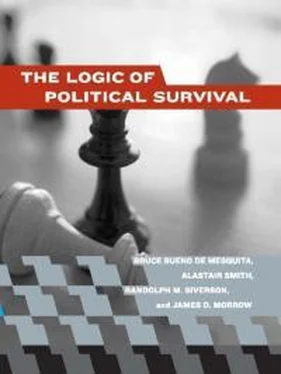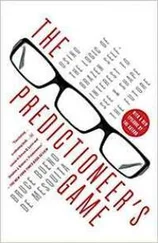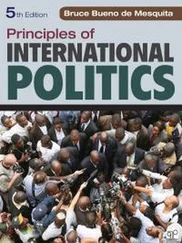The selectorate theory identifies conditions when a larger or smaller state ameliorates or exacerbates deviations from the public weal. Factions, the tyranny of the majority, and other departures from the common welfare are not always avoided by having a larger polity (including a larger selectorate), nor are they inherently prevented by smaller units. There is, in the logic of the selectorate theory, a natural tension between public welfare and the combination of the absolute size of the winning coalition and the ratio of the winning-coalition size to the size of the selectorate. In passing in chapters 5 and 10, we evaluate the size of republics and public welfare, taking into account specific aspects of institutional arrangements, including the relationship between coalition size and selectorate size and the choice between unitary or federal government and between parliamentary, mixed, and presidential democracy. We do so in a skeletal, simplified way, and are mindful that institutional setups and federalism have many characteristics and almost infinite variation. That institutional variation makes the division of a large unitary state into several smaller, partially self-governing federal entities only one important characteristic of governance. Still, the distinctions we draw allow us to reach general principles that distinguish expected policy choices in monarchies, juntas, rigged-election autocracies, list-voting proportional-representation systems, single-member district parliamentary systems, multimember district systems, and many presidential systems, while further distinctions can be drawn between unitary states and federal republics.
For some institutional arrangements a large size facilitates promoting the common good (conceived of here as the promotion of peace, freedom, and prosperity, as detailed in subsequent chapters), but for others, an expanded selectorate is predicted to diminish the public well-being. Factionalism can be promoted when the selectorate is small or large, though how it is promoted depends on the relationship between such institutions as the selectorate and winning coalition, on the one hand, and the pool of resources available to the government, on the other.
One proposition we deduce and evaluate empirically notes that the larger the winning coalition, the more inclined are its leaders to provide public policies that satisfy the welfare of their winning-coalition members, a group that typically represents a substantial portion of the society. But we will also see that special conditions can arise in which leaders in large states are liberated by a big selectorate to pay less attention to the public well-being than when the state’s selectorate was smaller. That is, the selectorate theory suggests an explanation for the different conclusions reached by Madison and Montesquieu. The evidence from history will allow us to assess this debate and our claims.
The Winning Coalition ( W )
The winning coalition is defined as a subset of the selectorate of sufficient size such that the subset’s support endows the leadership with political power over the remainder of the selectorate as well as over the disenfranchised members of the society. How many supporters are required to form a winning coalition depends on the mix of qualities required for membership in the winning coalition and on the degree to which those qualities relate to lumpy or broadly distributed characteristics within the selectorate. In exchange for their support, members of the winning coalition receive a share of whatever private benefits the incumbent doles out to her supporters.
In a hereditary monarchy, the lineage required for selectorate membership occurs among a defined subset of the population: the aristocracy or nobility. Anyone in that subset, by definition, is adequately endowed with the quality of lineage. Therefore, loosely speaking, the winning coalition must include approximately a simple majority of those with the necessary lineage. That is, a majority of the relevant aristocracy’s support is sufficient to ensure that an individual becomes or remains a monarch in a strictly hereditary system. Thus, both the selectorate and the winning coalition are small, with the ratio of the coalition to the selectorate being approximately one-half.
In a system that depends in part on control over weapons, by contrast, the requisite quality—arms—may be distributed unevenly. For example, election of the king of England in the twelfth century required support among the barons and was not determined purely by heredity. To be sure, noble birth was a requirement for membership in the selectorate, but it was not the only requirement for selection of the winning coalition, whose support was needed to elect and sustain the king. At the time John Lackland was elected king of England (1199) there were 197 lay barons and 39 ecclesiastical barons. These nobles (including some women, such as Constance, countess of Richmond) had the sole authority to vote for the king. To be king required support from a majority of them, or at least a majority of the knights fees they controlled, and, of course, the endorsement of the pope. Knights fees provide a useful albeit imperfect index of the wealth of each baron (or baroness) and of his or her ability to muster military might in support of his or her candidate for the crown. In a contested election for king—and John’s election was contested—control over a majority, or even supermajority, of knights may have been essential. The winning coalition, then, consisted of a subset of the barons such that the subset controlled a sufficient number of knights. Control over knights, however, was not evenly distributed. John, for instance, in his capacity as the earl of Gloucester, held 300 knights fees. Others held nearly as many, but still other barons held only a handful. Aubrey de Vere, earl of Oxford, held only 30 knights fees yet was still among the more influential barons. Just how many barons were needed depended on the specific mix included in the winning coalition. To illustrate this point we construct an example based on the situation in England in 1199.
England’s 236 barons collectively controlled 7,200 knights fees in 1199. Sidney Painter (1949, 19-24) notes that just 60 lay baronies held 4,632 knights fees, while 15 ecclesiastical baronies accounted for another 820. Indeed, 75 percent of the knights fees belonged to barons who held 30 or more. The 10 most powerful barons collectively possessed around 1,850 knights fees. The 20 most powerful barons collectively had approximately 3,000 knights fees. With fewer than 60 barons, the king could muster support from two-thirds of the knights fees. With that much backing, he could be confident of military victory if the remaining barons and their knights opposed him.
The election of John Lackland, earl of Gloucester, as king of England shows that political domination may require control over a majority or even supermajority of the requisite qualities, but those qualities may fall within the hands or under the control of a subset of the selectorate that is much smaller than a majority of individual members. In modern times military juntas illustrate the same principle. That is, the selectorate is small and the winning coalition often requires support from among fewer than half of the senior officers who collectively control a majority or more of the nation’s soldiers and arms. 6
To further illustrate the point that a coalition can be considerably less than half of the selectorate, consider the size of a winning coalition in a rigged electoral system, like the systems that have operated in Iraq, Kenya, and many other places, including the Soviet Union. In the Soviet Union, as in many other similar systems, the selectorate arguably consisted of as many as all adult citizens. That is, selectorate membership was determined solely by age and birthplace/naturalization criteria. The winning coalition, however, consisted of the subset of people who met the selectorate-membership criteria and, in addition, who possessed a defined special proficiency or quality, including critically membership in the Communist Party. Party membership was emblematic of acceptance of a set of beliefs and principles without which one could not be in a winning coalition.
Читать дальше












